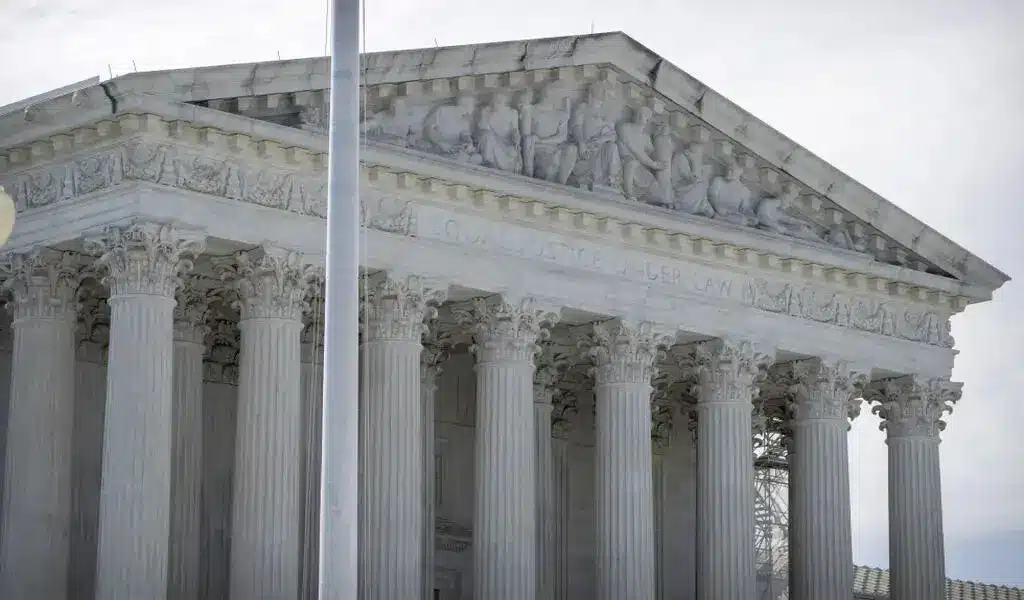News
U.S. Warns Ceasefire In Gaza May Aid Hamas, While Humanitarian Concerns Mount

(CTN NEWS) – On Monday, the United States issued a warning that a potential ceasefire in Gaza could play into the hands of Hamas by affording the group an opportunity to recuperate, rearm, and prepare for future attacks against Israel.
State Department spokesman Matthew Miller elaborated on these concerns, stating that a ceasefire might give Hamas the time it needs to regroup, refit, and resume launching terrorist attacks.
He highlighted the intolerable situation Israel faces, given its history of enduring brutal terrorist attacks and ongoing threats at its borders.
Miller emphasized that the United States is actively working on delivering humanitarian relief to Gaza.
David Satterfield, a U.S. envoy, is on the ground, intensively focused on aid efforts to alleviate the dire humanitarian situation in the region.
Gaza’s health ministry reported on Monday that Israeli airstrikes have resulted in a substantial number of casualties.
To date, over 5,087 Palestinians, including 2,055 children, have lost their lives since the conflict began following the October 7 Hamas attack on Israel, which claimed 1,400 lives.
In addition to the staggering death toll, more than 15,000 individuals have sustained injuries during this period.
With the conflict now extending beyond two weeks, concerns about the worsening humanitarian crisis in Gaza are growing.
European Union foreign policy chief Josep Borrell revealed that EU leaders are considering supporting a call for a temporary ceasefire to facilitate the delivery of humanitarian aid and provide shelter for displaced individuals.
This decision reflects a shared international commitment to addressing the escalating humanitarian catastrophe in Gaza while ensuring regional stability.

Israel-Hamas Urban Warfare Intensifies Following 300 Strikes on Gaza in 24 Hours
In the last 24 hours, Israel has reported over 300 airstrikes in the Gaza Strip, leading to dozens of casualties, according to Hamas, the governing authority in the besieged Palestinian territory.
Israel has also claimed to engage in ground clashes with Hamas.
A third aid convoy, consisting of around a dozen trucks carrying much-needed supplies, entered Gaza from Egypt on Monday via the Rafah crossing, which is not under Israeli control.
The United States, which has been involved in facilitating the entry of aid convoys, has promised to ensure a continuous flow of humanitarian goods into Gaza.
The region has been facing shortages of water, food, power, and fuel due to Israel’s restrictions.
Fighting has persisted despite Israeli Prime Minister Benjamin Netanyahu’s repeated vow to “eliminate Hamas,” and there is the looming threat of a full-scale ground invasion.
Gaza’s government media office, controlled by Hamas, reported that more than 60 people were killed in the overnight airstrikes, with 17 deaths in a single strike on a house in northern Gaza.
At least 10 more people were killed in new strikes on Monday morning.
The Israeli military claimed to have targeted “over 320 military targets in the Gaza Strip” in the 24-hour period leading up to Monday.
These targets included tunnels housing Hamas fighters, operational command centers, military compounds, and observation posts used by the militant group Islamic Jihad.
Residents in Rafah described moments of terror, with a thick smoke clouding the area after airstrikes.
Israeli forces have gathered near the Gaza border, with smaller units conducting limited incursions in the hope of rescuing hostages, estimated to be 222 by Israel.
During one such operation, a 19-year-old Israeli soldier was killed, and three others were wounded.
The tank operation aimed to “dismantle terror infrastructure, locate missing persons and bodies.”
Tensions have also flared in the occupied West Bank, where clashes involving Israeli security forces or settlers have resulted in the deaths of 95 Palestinians since the conflict began in Gaza, according to the health ministry in Ramallah.
Meanwhile, Israel continues to evacuate southern communities near Gaza.

Dire Need In Gaza
Hamas militants launched a major attack on southern Israel from Gaza on October 7, marking one of the worst incidents in Israel’s 75-year history.
The attack primarily targeted civilians, and it resulted in deaths, injuries, and the burning of many bodies, according to Israeli officials.
Concerns have been mounting over the dire humanitarian needs of the 2.4 million civilians trapped in the densely populated 40-kilometer-long coastal strip.
Even before the conflict, Gaza was facing severe blockades and economic challenges.
In the southern city of Khan Yunis, children killed in an Israeli airstrike were laid to rest, while in Rafah, people resorted to filling containers with portable water.
Last week, US President Joe Biden facilitated the entry of humanitarian aid convoys into Gaza through negotiations with Egyptian and Israeli leaders.
However, the United Nations estimates that Gaza requires approximately 100 truckloads of relief supplies daily.
Martin Griffiths, the UN’s aid chief, referred to Sunday’s delivery of food, water, and medical supplies as “another small glimmer of hope for the millions of people in dire need of humanitarian aid.”
Still, he emphasized that more significant efforts were necessary.
Israel has refrained from allowing fuel into Gaza due to concerns that Hamas could use it for weapons and explosives.
As a result, Gaza’s ambulances, hospital incubators, and water desalination plants face the risk of ceasing operations.

Nearly 20,000 Displaced in Lebanon Following Border Clashes with Israel
As tensions rise along the Lebanese-Israeli border in the aftermath of the Gaza conflict, a significant humanitarian concern has emerged.
The International Organization for Migration reported on Monday that nearly 20,000 people have been internally displaced within Lebanon since early October.
This internal displacement crisis began on October 8, a day after a Hamas militant attack on Israel and Israel’s subsequent military incursion into Gaza.
Most of these displaced individuals come from southern Lebanon, an area that has seen a significant movement of people fleeing the conflict.
While the majority are from southern Lebanon, there have also been reports of people relocating from other areas in response to the ongoing crisis.
In addition to this internal displacement, Israeli authorities have initiated evacuation measures for various cities and localities in the northern region of the country.
The situation along the Lebanese-Israeli border has escalated into one of the most intense exchanges of fire between Israel and Lebanon’s heavily armed Hezbollah militia since their conflict in 2006.
The humanitarian impact of this displacement is substantial, with families and communities being uprooted from their homes, schools, and workplaces.
Addressing the urgent needs of these displaced individuals, including shelter, food, clean water, and medical assistance, is a critical challenge that requires swift and coordinated efforts from humanitarian organizations and governments.
The situation highlights the broader repercussions of conflicts in the region and underscores the necessity for diplomatic efforts to achieve lasting peace and stability in the Middle East.
The plight of those affected by the conflict in Lebanon serves as a poignant reminder of the importance of finding peaceful solutions to regional disputes to prevent further suffering and displacement.

Hezbollah Warning
Throughout the world, both Israel’s allies and adversaries have expressed concerns about the Gaza conflict escalating into a broader regional crisis.
Iran, a longstanding adversary of Israel, has repeatedly cautioned against further escalation.
Armed groups allied with Iran, such as Lebanon’s Hezbollah, have engaged in cross-border exchanges of fire with Israel, adding to the concerns of a wider conflict.
On the domestic front, Israeli Prime Minister Benjamin Netanyahu issued a stern warning.
He stated that if Hezbollah became more deeply involved, it would be a grave mistake on their part.
He emphasized that Israel would respond with overwhelming force, resulting in dire consequences for both Hezbollah and Lebanon.
In a joint statement, President Joe Biden and leaders from Western countries emphasized the importance of preventing the conflict from spreading and maintaining stability in the Middle East.
Reports have emerged of Israeli airstrikes targeting two airports in Syria, a mosque used by groups considered as terrorists in the West Bank city of Jenin, and military infrastructure linked to Hezbollah within Lebanon.
These actions have raised concerns about potential further escalation and the involvement of various regional actors.
Hamas, Hezbollah, and the Syrian government all have the backing of Iran, a nation that vehemently opposes Israel’s existence.
Iran has warned that the situation in the region could spiral “out of control,” underscoring the potential for a broader and more devastating conflict.
The United States has also expressed its readiness to act in case of any escalation.
The Pentagon recently announced increased military readiness in the region.
U.S. Defense Secretary Lloyd Austin advised against any group or country seeking to expand the conflict, emphasizing the need for restraint and diplomacy during this challenging period.
MORE RELATED NEWS:
US rejects Israel-Gaza ceasefire as Hamas released 2 female hostages
LEGEND LOST: Veteran Indian Spinner Bishan Singh Bedi Died at the age of 77
Israeli and Hamas Troops Clash on the Ground as the Death Toll in Gaza Rises to 5,087

News
Google’s Search Dominance Is Unwinding, But Still Accounting 48% Search Revenue

Google is so closely associated with its key product that its name is a verb that signifies “search.” However, Google’s dominance in that sector is dwindling.
According to eMarketer, Google will lose control of the US search industry for the first time in decades next year.
Google will remain the dominant search player, accounting for 48% of American search advertising revenue. And, remarkably, Google is still increasing its sales in the field, despite being the dominating player in search since the early days of the George W. Bush administration. However, Amazon is growing at a quicker rate.
Google’s Search Dominance Is Unwinding
Amazon will hold over a quarter of US search ad dollars next year, rising to 27% by 2026, while Google will fall even more, according to eMarketer.
The Wall Street Journal was first to report on the forecast.
Lest you think you’ll have to switch to Bing or Yahoo, this isn’t the end of Google or anything really near.
Google is the fourth-most valued public firm in the world. Its market worth is $2.1 trillion, trailing just Apple, Microsoft, and the AI chip darling Nvidia. It also maintains its dominance in other industries, such as display advertisements, where it dominates alongside Facebook’s parent firm Meta, and video ads on YouTube.
To put those “other” firms in context, each is worth more than Delta Air Lines’ total market value. So, yeah, Google is not going anywhere.
Nonetheless, Google faces numerous dangers to its operations, particularly from antitrust regulators.
On Monday, a federal judge in San Francisco ruled that Google must open up its Google Play Store to competitors, dealing a significant blow to the firm in its long-running battle with Fortnite creator Epic Games. Google announced that it would appeal the verdict.
In August, a federal judge ruled that Google has an illegal monopoly on search. That verdict could lead to the dissolution of the company’s search operation. Another antitrust lawsuit filed last month accuses Google of abusing its dominance in the online advertising business.
Meanwhile, European regulators have compelled Google to follow tough new standards, which have resulted in multiple $1 billion-plus fines.

Pixa Bay
Google’s Search Dominance Is Unwinding
On top of that, the marketplace is becoming more difficult on its own.
TikTok, the fastest-growing social network, is expanding into the search market. And Amazon has accomplished something few other digital titans have done to date: it has established a habit.
When you want to buy anything, you usually go to Amazon, not Google. Amazon then buys adverts to push companies’ products to the top of your search results, increasing sales and earning Amazon a greater portion of the revenue. According to eMarketer, it is expected to generate $27.8 billion in search revenue in the United States next year, trailing only Google’s $62.9 billion total.
And then there’s AI, the technology that (supposedly) will change everything.
Why search in stilted language for “kendall jenner why bad bunny breakup” or “police moving violation driver rights no stop sign” when you can just ask OpenAI’s ChatGPT, “What’s going on with Kendall Jenner and Bad Bunny?” in “I need help fighting a moving violation involving a stop sign that wasn’t visible.” Google is working on exactly this technology with its Gemini product, but its success is far from guaranteed, especially with Apple collaborating with OpenAI and other businesses rapidly joining the market.
A Google spokeswoman referred to a blog post from last week in which the company unveiled ads in its AI overviews (the AI-generated text that appears at the top of search results). It’s Google’s way of expressing its ability to profit on a changing marketplace while retaining its business, even as its consumers steadily transition to ask-and-answer AI and away from search.

Google has long used a single catchphrase to defend itself against opponents who claim it is a monopoly abusing its power: competition is only a click away. Until recently, that seemed comically obtuse. Really? We are going to switch to Bing? Or Duck Duck Go? Give me a break.
But today, it feels more like reality.
Google is in no danger of disappearing. However, every highly dominating company faces some type of reckoning over time. GE, a Dow mainstay for more than a century, was broken up last year and is now a shell of its previous dominance. Sears declared bankruptcy in 2022 and is virtually out of business. US Steel, long the foundation of American manufacturing, is attempting to sell itself to a Japanese corporation.
SOURCE | CNN
News
2024 | Supreme Court Won’t Hear Appeal From Elon Musk’s X Platform Over Warrant In Trump Case

Washington — Trump Media, The Supreme Court announced Monday that it will not hear an appeal from social media platform X about a search warrant acquired by prosecutors in the election meddling case against former President Donald Trump.
The justices did not explain their rationale, and there were no recorded dissents.
The firm, which was known as Twitter before being purchased by billionaire Elon Musk, claims a nondisclosure order that prevented it from informing Trump about the warrant obtained by special counsel Jack Smith’s team violated its First Amendment rights.
The business also claims Trump should have had an opportunity to exercise executive privilege. If not reined in, the government may employ similar tactics to intercept additional privileged communications, their lawyers contended.
Supreme Court Won’t Hear Appeal From Elon Musk’s X Platform Over Warrant In Trump Case
Two neutral electronic privacy groups also joined in, urging the high court to hear the case on First Amendment grounds.
Prosecutors, however, claim that the corporation never shown that Trump utilized the account for official purposes, therefore executive privilege is not a problem. A lower court also determined that informing Trump could have compromised the current probe.

Trump utilized his Twitter account in the weeks preceding up to his supporters’ attack on the Capitol on January 6, 2021, to spread false assertions about the election, which prosecutors claim were intended to create doubt in the democratic process.
The indictment describes how Trump used his Twitter account to encourage his followers to travel to Washington on Jan. 6, pressuring Vice President Mike Pence to reject the certification, and falsely claiming that the Capitol crowd, which battered police officers and destroyed glass, was peaceful.
Supreme Court Won’t Hear Appeal From Elon Musk’s X Platform Over Warrant In Trump Case
That case is now moving forward following the Supreme Court’s verdict in July, which granted Trump full immunity from criminal prosecution as a former president.
The warrant arrived at Twitter amid quick changes implemented by Musk, who bought the company in 2022 and has since cut off most of its workforce, including those dedicated to combating disinformation and hate speech.
SOURCE | AP
News
The Supreme Court Turns Down Biden’s Government Appeal in a Texas Emergency Abortion Matter.

(VOR News) – A ruling that prohibits emergency abortions that contravene the Supreme Court law in the state of Texas, which has one of the most stringent abortion restrictions in the country, has been upheld by the Supreme Court of the United States. The United States Supreme Court upheld this decision.
The justices did not provide any specifics regarding the underlying reasons for their decision to uphold an order from a lower court that declared hospitals cannot be legally obligated to administer abortions if doing so would violate the law in the state of Texas.
Institutions are not required to perform abortions, as stipulated in the decree. The common populace did not investigate any opposing viewpoints. The decision was made just weeks before a presidential election that brought abortion to the forefront of the political agenda.
This decision follows the 2022 Supreme Court ruling that ended abortion nationwide.
In response to a request from the administration of Vice President Joe Biden to overturn the lower court’s decision, the justices expressed their disapproval.
The government contends that hospitals are obligated to perform abortions in compliance with federal legislation when the health or life of an expectant patient is in an exceedingly precarious condition.
This is the case in regions where the procedure is prohibited. The difficulty hospitals in Texas and other states are experiencing in determining whether or not routine care could be in violation of stringent state laws that prohibit abortion has resulted in an increase in the number of complaints concerning pregnant women who are experiencing medical distress being turned away from emergency rooms.
The administration cited the Supreme Court’s ruling in a case that bore a striking resemblance to the one that was presented to it in Idaho at the beginning of the year. The justices took a limited decision in that case to allow the continuation of emergency abortions without interruption while a lawsuit was still being heard.
In contrast, Texas has been a vocal proponent of the injunction’s continued enforcement. Texas has argued that its circumstances are distinct from those of Idaho, as the state does have an exemption for situations that pose a significant hazard to the health of an expectant patient.
According to the state, the discrepancy is the result of this exemption. The state of Idaho had a provision that safeguarded a woman’s life when the issue was first broached; however, it did not include protection for her health.
Certified medical practitioners are not obligated to wait until a woman’s life is in imminent peril before they are legally permitted to perform an abortion, as determined by the state supreme court.
The state of Texas highlighted this to the Supreme Court.
Nevertheless, medical professionals have criticized the Texas statute as being perilously ambiguous, and a medical board has declined to provide a list of all the disorders that are eligible for an exception. Furthermore, the statute has been criticized for its hazardous ambiguity.
For an extended period, termination of pregnancies has been a standard procedure in medical treatment for individuals who have been experiencing significant issues. It is implemented in this manner to prevent catastrophic outcomes, such as sepsis, organ failure, and other severe scenarios.
Nevertheless, medical professionals and hospitals in Texas and other states with strict abortion laws have noted that it is uncertain whether or not these terminations could be in violation of abortion prohibitions that include the possibility of a prison sentence. This is the case in regions where abortion prohibitions are exceedingly restrictive.
Following the Supreme Court’s decision to overturn Roe v. Wade, which resulted in restrictions on the rights of women to have abortions in several Republican-ruled states, the Texas case was revisited in 2022.
As per the orders that were disclosed by the administration of Vice President Joe Biden, hospitals are still required to provide abortions in cases that are classified as dire emergency.
As stipulated in a piece of health care legislation, the majority of hospitals are obligated to provide medical assistance to patients who are experiencing medical distress. This is in accordance with the law.
The state of Texas maintained that hospitals should not be obligated to provide abortions throughout the litigation, as doing so would violate the state’s constitutional prohibition on abortions. In its January judgment, the 5th United States Circuit Court of Appeals concurred with the state and acknowledged that the administration had exceeded its authority.
SOURCE: AP
SEE ALSO:
Could Last-Minute Surprises Derail Kamala Harris’ Campaign? “Nostradamus” Explains the US Poll.
-

 News4 years ago
News4 years agoLet’s Know About Ultra High Net Worth Individual
-
Entertainment2 years ago
Mabelle Prior: The Voice of Hope, Resilience, and Diversity Inspiring Generations
-
News11 years ago
Enviromental Groups Tell Mekong Leaders Lao Dam Evaluation Process Flawed
-

 Health4 years ago
Health4 years agoHow Much Ivermectin Should You Take?
-

 Tech3 years ago
Tech3 years agoTop Forex Brokers of 2023: Reviews and Analysis for Successful Trading
-

 Lifestyles3 years ago
Lifestyles3 years agoAries Soulmate Signs
-

 Entertainment3 years ago
Entertainment3 years agoWhat Should I Do If Disney Plus Keeps Logging Me Out of TV?
-

 Health3 years ago
Health3 years agoCan I Buy Ivermectin Without A Prescription in the USA?


